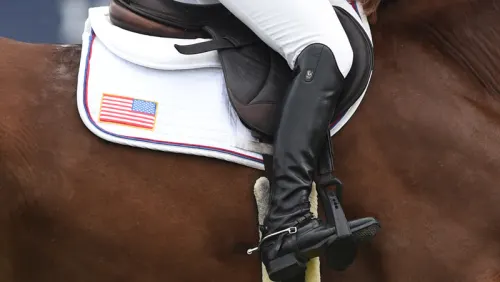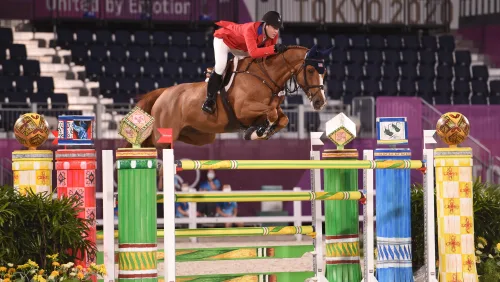 The Belgians Are Aiming For Another Medal
The Belgians Are Aiming For Another Medal
With Ludo Philippaerts and Jos Lansink, they could just follow up their 2002 World Championship bronze medal with their first Olympic medal since 1976, writes Birgit Popp.
Ingmar de Voss, the general secretary of the Belgian Equestrian Federation, has been facing a new problem.
“This year I have to choose for the first time which riders I am taking on the team,” he said. “Normally, we had two, maybe three riders of top quality; the others were more or less to fill the team. This year we have six combinations, which would all be worthy for the team. But I’m glad to have this luxury, and, of course, I would be very happy if we win a team medal again.”
And their chances aren’t bad, as the four Samsung Super League Nations Cup events of this year have shown. In June, at Rotterdam (the Netherlands) and Lucerne (Switzerland) the Belgian team was runner-up. At La Baule (France) in May they placed third. Only at Rome (Italy) at the end of May did they disappoint, finishing eighth and last.
The 2002 WEG bronze-medal team included Jos Lansink and Caridor Z (who were sixth individually), Philippe LeJeune riding Nabab de Reve, Stanny van Paesschen riding O de Pomme, and Peter Postelmans aboard Oleander. The individual silver medalist at the 2001 European Championships, Ludo Philippaerts, for many years the strongest Belgium rider, missed that team because Darco was ill. And they just missed the bronze at the 2003 European Championships, with Philippaerts and Parco.
The Athens team was to be decided after CHIO Aachen, where the team of Dirk Demeersman on Clinton, Lansink on Cumano, Philippaerts on Parco, and Marc van Dijck on Verelst Goliath finished fifth, 12 faults behind the winning Germans. LeJeune and Kasimir de Schuttershof are still under consideration, as is van Paesschen and O de Pomme, who didn’t show at Aachen.
Lansink, who changed his nationality from Dutch to Belgian in 2001, and Philippaerts are the team anchors. With the 12-year-old Parco, a son of his former international star Darco, Philippaerts was 11th in the 2002 World Cup Final and was 11th in this year’s final. Philippaerts rode on his first Nations Cup team in 1986. He competed in his first international championships in 1989. In the 1990 World Championships he placed sixth individually aboard Darco. In the 1992 Olympics he and Darco achieved a respectable seventh, although the team was only 12th. In the 2000 Sydney Olympics, Philippaerts participated as an individual and just missed a medal with Otterongo, another son of Darco, as they placed fourth.
This season Philippaerts has participated in all four Super League events and twice achieved double-clear rounds with Parco.
Lansink has participated in an equal number of championships and has a better crop of medals. From 1982 to 1996 Lansink, who started riding at age 3, worked for the former Dutch team coach Hans Horn. In May 1996 he succeeded Piet Raymakers at Leon Melchior’s stud farm Zangersheide in Belgium, the reason he finally changed his nationality.
ADVERTISEMENT
His international breakthrough was with Felix, placing seventh individually and fifth with the team in the 1988 Seoul Olympics. In Libero H, Lansink found the right successor for Felix, and aboard the Holsteiner stallion he was 11th individually at the 1990 WEG and won the team title and the individual bronze medal at the ’91 Europeans. With Egano, Lansink earned the team gold medal at the 1992 Barcelona Olympics. His greatest individual success was winning the 1994 World Cup Final with Libero H.
LeJeune rode his first Nations Cup in 1980. In 1988 he attracted public attention when he placed third aboard Nistria in the World Cup Final. He spent 1986 to ’88 in Switzerland, but when Nistria was sold he returned to Belgium to build his own stable. His first European Championships were in 1991, and he’s ridden in five since then.
The 44-year-old rider, who also plays tennis, golf and skis, represented Belgium in the ’94 and ’98 World Championships.
Kashmir vd Schuttershof is a son of his WEG team bronze medalist Nabab de Reve.
Marc van Dijck, who represented his nation in the 2001 Europeans aboard Verelst Goliath, nearly rode on the 2002 WEG team. In Rotterdam’s Nations Cup he achieved with Goliath a 4 and a clear round, showing that this very capable horse has become much more consistent.
Van Paesschen and O de Pomme, a son of 1996 individual gold medalist Jus de Pomme, were the co-leaders of the 2002 WEG bronze-medal team, since both they and Lansink aboard Caridor Z had double-clear rounds in the team competition. They placed 20th individually.
In last year’s Europeans they also showed a consistent performance with a total of just 5 faults in the Nations Cup. But individually they weren’t as successful, placing just 43rd with a disastrous first round. But they produced a double-clear performance in the Nations Cup at Lucerne (Switzerland) earlier this year.
Van Paesschen is the Belgian rider with the longest championship history. He participated in the 1975, 1989, 1995 and 2003 Europeans, the 1986, 1990 and 2002 World Championships, and the 1976 and 1996 Olympic Games.
Demeersman and Clinton also posted a double-clear round in the Nations Cup at Lucerne and were 11th in the grand prix. Demeersman has represented his country once in an international championship–the 1992 Barcelona Olympics–where the team was 12th.
ADVERTISEMENT
Team Members
Parco: gr. s., 12, Belgian-bred by Darco–Attack mare.
Ludo Philippaerts: age 41, Meeuwen-Gruitrode.
AK Cumano: gr. s., 11, German-bred Holsteiner by Cassinni–Landgraf I mare.
Jos Lansink: age 43, Weerselo.
Clinton: gr. s., 11, German-bred Holsteiner by Corrado–Masetto mare.
Dirk Demeersman: age 40, Sint Truiden.
Kashmir vd Schuttershof: br. s., 10, Belgian-bred by Nabab de Reve– Tenor mare.
Philippe LeJeune: age 44, Hoeilaart.
Verelst Goliath: b. g., 12, German-bred Holsteiner by Capitol I–Caletto I mare.
Marc van Dijck: age 44, Nieuwenrode.
O de Pomme: by Jus de Pomme.
Stanny van Paesschen: age 47, Ekeren.














